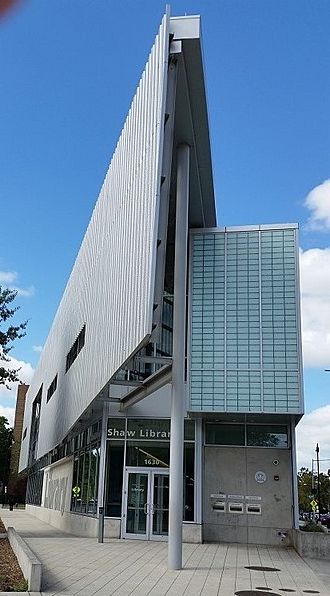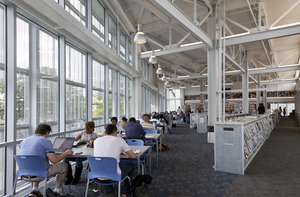Shaw Library facts for kids
Quick facts for kids Shaw Neighborhood/Watha T. Daniel Library |
|
|---|---|

East entrance to the Shaw Library, October 2015
|
|
| General information | |
| Status | Complete |
| Type | Public Library |
| Location | 1630 7th St. NW, Washington D.C. |
| Coordinates | 38°54′44″N 77°01′21″W / 38.91236°N 77.02251°W |
| Completed | 2010 |
| Opening | August 2010 |
| Cost | $12 million |
| Owner | DC Public Library |
| Management | DC Public Library |
| Technical details | |
| Floor count | 3 |
| Floor area | 22,800 sq ft (2,100 m2) |
| Design and construction | |
| Architect | Davis Brody Bond Aedas |
| Developer | DC Public Library |
| Structural engineer | Delon Hampton |
| Main contractor | Forrester Construction Company |
The Shaw Neighborhood Library, also known as the Watha T. Daniel Library, is a modern and award-winning building in Washington, D.C.. It is part of the District of Columbia Public Library system. This library was first built in 1975 with two floors. Later, it was completely updated and reopened in August 2010 as a three-story building. Its unique design, with a see-through front and bright inside, makes it a great example for future libraries.
Contents
A Look Back: The Library's History
The Shaw Library first opened its doors on September 27, 1975. The mayor at the time, Walter Washington, led the opening ceremony. The first building cost $1.2 million to build. It had a reading room for adults, a lounge, and a listening area on the first floor. The second floor was for children, with a special space for story times. This original building was taken down in 2004 to make way for the new design.
Major Updates: A New Beginning
Big plans for renovating the library began in 2007. These updates were part of a larger effort to improve many libraries in D.C. The final cost for the new Shaw Library was about $12 million. The head librarian, Ginnie Cooper, said that the Shaw Library's renovation was the most amazing transformation of all the projects.
The library is named after Watha T. Daniel. He was a master plumber and a respected community leader in the Shaw neighborhood. He was the first chairman of the D.C. Model Cities Commission and passed away in 1971.
Amazing Design: Inside and Out
The library building is about 22,800 sq ft (2,100 m2) in size. It sits on a triangular piece of land. The building has three floors: one is underground, and two are above ground. When you enter from the east side, you come into the main lobby. This lobby leads to the lower level, which has spaces for community events.
Bright and Eco-Friendly Features
A special part of the building is its wavy, metal screen on the south side. This screen sticks out like the front of a ship. It has many small holes, letting in light while also providing shade. This helps keep the upper reading room cool and bright. It also protects the books from too much sun. The design uses natural light from all sides, reducing the need for electric lights.
The new library was built to be very eco-friendly. It earned a LEED Gold Certification. This means it uses less energy and is better for the environment. Some of its green features include:
- A green roof with plants on top.
- A special air system that saves energy.
- Ways to control sunlight and use natural daylight.
- Using materials that can be recycled or are renewable.
The design for the new library changed a few times. At one point, there were ideas to use less glass because of budget limits. This was also due to finding out that the Metro subway system had a tunnel and a large vent under the library site. This made construction more complex and costly.
What You Can Find: Resources and Community
The Shaw Library is more than just a place for books. It's also a "hybrid community, recreation, and learning center."
Books, Computers, and More
The library holds about 40,000 items. These include books, DVDs, and CDs. It has space for up to 80,000 items in total. For computer access, there are:
- 32 public computers.
- Free Wi-Fi Internet access.
- 8 Mac computers in the teen area.
There is comfortable seating for 200 people. The library also has a large room for programs that can hold up to 100 people. There are two smaller meeting rooms for 12 people each. You can also find a vending area for snacks.
Fun Activities and Events
The library offers many community activities. You might find yoga classes or Bollywood dance classes here. The facilities are also used for important local announcements, like those from the mayor.
Special Art and Messages
When you enter the library, you'll see a 22-foot neon sculpture. It was created by local artist Craig A. Kraft. The artwork is called Vivace. The artist says it was inspired by jazz music. It aims to show the "spirit of creativity, vibrancy, and color" of the Shaw neighborhood.
Inside, on the upper level, there is a large mural. It shows a collage of portraits of over 250 people from the community. It also features an inspiring quote from President Barack Obama’s first speech as president. The quote talks about how our different backgrounds make us strong. It also speaks about how people can come together and find common ground.


